アタッカー勢で模写、迅だけ上手くいかなくてトレスです。当たり前のように単行本未登場キャラがいますごめんな。そのうちまた増えるかも





アタッカー勢で模写、迅だけ上手くいかなくてトレスです。当たり前のように単行本未登場キャラがいますごめんな。そのうちまた増えるかも
古武術 天心流兵法さん(tenshinryu.tumblr.com)
More Posts from Zelo-ref and Others

Lanvin S/S 2011
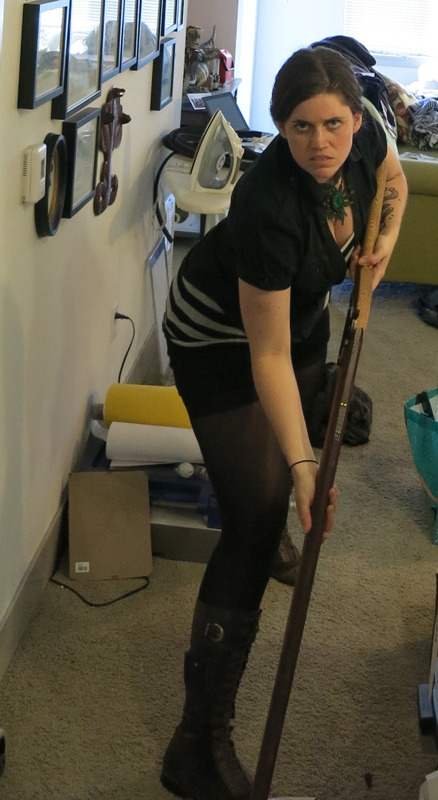

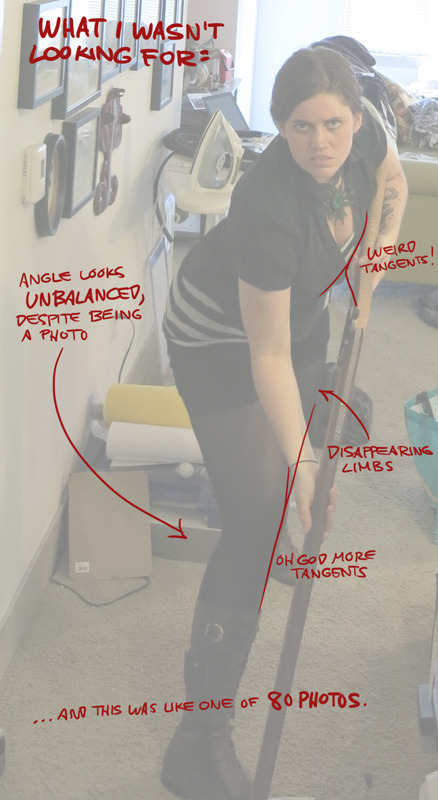


So I was chatting with the lovely Justin Oaksford yesterday, and he casually asked if I used photo reference for my recent Rolemodels piece- not as a bad thing, but because the pose and the camera angle read well. Pretty sure I grinned like an idiot when he brought it up because, goddammit, I’m proud that the work shows! I’ve felt like my work has been somewhat stilted as of late- I could feel myself subconsciously trending towards easier angles, easier poses, easier expressions just because it's slightly less frustrating for my brain to process- so getting that confirmation from a colleague was pretty damn satisfying.
I think there’s a tendency for artists to take pride in being able to draw out of your head, and, while that’s an admittedly important skill, what’s actually important is what that skill implies- it implies that you’ve internalized reference. That you’ve spent so much time looking at the world around you, studying it, drawing from it, breaking it down, that you’ve amassed an extensive mental library that you can draw from. You are Google reborn in the shallow husk of a human being.
But heck, the world’s a big place- what are the chances that you ever get to a point that you’ve internalized all of it? Internalized it AND ALSO are never going to forget it ever? Probably no chance at all. Sorry buddy. So rather than bemoaning the fact that we don’t have impenetrable search engine cyborg brains- yet- you sure as hell better still be using reference to fill in/refresh those empty shelves in your mental library. You shouldn’t have worm-ridden books about dinosaur anatomy from the 60’s in there. Stegosauruses with brains in their tails? CLEAN THAT SHIT OUT.
So my general process for using reference of any sort is:
loose thumbnails and brainstorming. If you have an idea, get that raw thing- unadulterated in it’s potential shittiness- onto paper. Good art is a combination of both instinct and discipline, so you don’t want to entirely discount those lightning strikes of brilliance. Or idiocy. Happens to all of us.
research and reference. Start gathering and internalizing whatever reference is pertinent to your piece- could be diagrams, art, photos, good old-fashioned READIN’, whathaveyou. Please note that this doesn’t mean find one picture of a giraffe- this means find tons of photos of giraffes, read about giraffes, understand giraffes, and learn how to incorporate that knowledge into your art with purpose and intent (Justin uses the word “intent” a lot so I’m stealing it). Don’t blindly copy what you see, but understand how to integrate it in an interesting and informed manner.
studies and practice. Could be lumped in with the previous step, granted, but it’s worth reiterating- if you’re drawing something new, it’s worth doing some studies. You discover things that you wouldn’t otherwise by just staring at them. It’s weird how I’m still learning this- “Gee golly, six-shooters are way easier to draw now that I’ve drawn a ton of them!” Yes wow Claire BRILLIANT. Gold star.
go for the gold. Finally, I’m sure it goes without saying, you integrate all of that research and knowledge into your initial thumbnails. If you learned something about anatomy, or fashion, or color, or butts, now you can drastically improve your original idea with this newfound knowledge. Also, per the images above, this is also your chance to improve on the reference- photos are a fantastic tool, but trust your instincts. Cameras can’t make informed decisions.
…So that’s my soapbox- it’s pretty easy, and it’s totally worth it. Research and reference lets you stand on the shoulders of giants- it lends legitimacy, specificity, and allure to your work that wouldn’t be there if you were just drawing out of your head 100% of the time. To put it simply- it makes your work ownable. It makes you stand out.
It makes you a better artist. :)
-C



a softer sequel to this
(please dont repost without credit)
Really usefull
I'm kinda ashamed to ask this, but could you make a tutorial on how to draw hands? ;A;
omg dont be ashamed at all!! Hands are generally tough to get used to, lots of artists struggle with it! so dont be ashamed i feel you.
and I actually have made a hand anatomy guide before in fact! If you want to get better at drawing hands I def recommend you learn the basic anatomy first. Please check out the ones I made, I try to make it simple and easy to understand:
Artistic Anatomy: Hands Part 1
Artistic Anatomy: Hands Part 2
There’s my guide to the anatomy, but here’s some more tips that I’ve noted to myself that I’d like to include
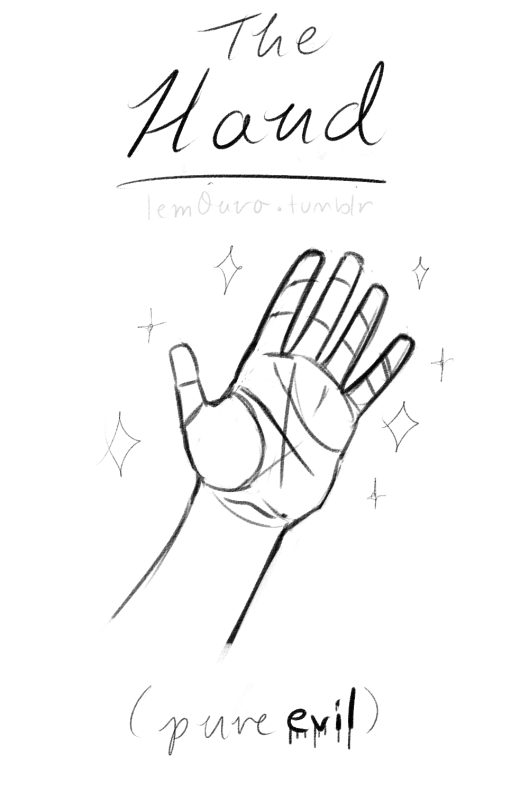
First off, I’d like to just note on the fingers: if you pay close attention to your own hand, you may notice the fingers are ever ever so slightly curved inward. It’s a very subtle detail, but I noticed that, despite how slight it is, it can make a hand look more lively, and less stiff.
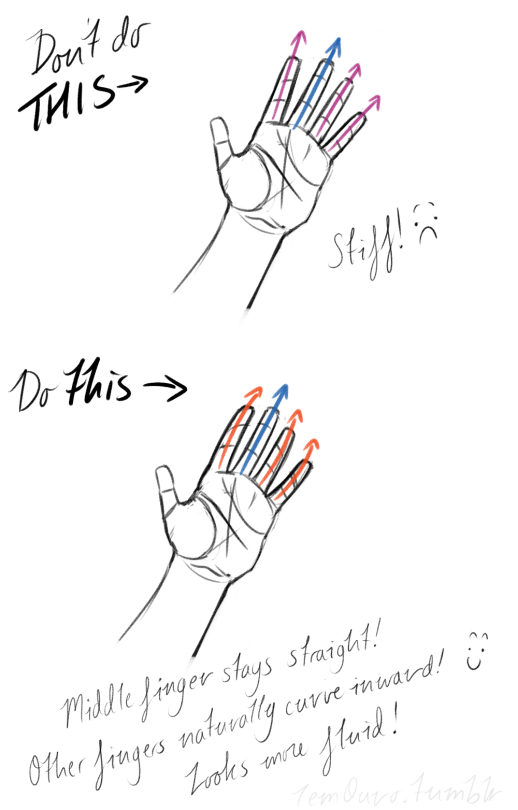
Second, the “M” on the palm! Your hand moves in many ways, and because it does it creates creases in your hand. The most prominent creases appear to make an M shape; this is handy to remember for what I’m going to talk about next. (It also could be a “W” I guess, or to be more specific a “ )X( “; just think of it in whatever way helps you remember!)

SO now that you see the M, draw your hand as a basic blocked shape and add your details. As you do, you can see that the M divides the palm into four basic parts!


When the hand moves, parts A, B, or C of the palm, alone or in different combos, will create the general poses that the hands do normally. These parts are the parts that move, with D being stationary, no matter what!
Here’s a chart of all the possible combos. Once you have down what part of the hand moves for a certain pose, you can change up the fingers and tweak it a bit to do what you need to make it more specific!
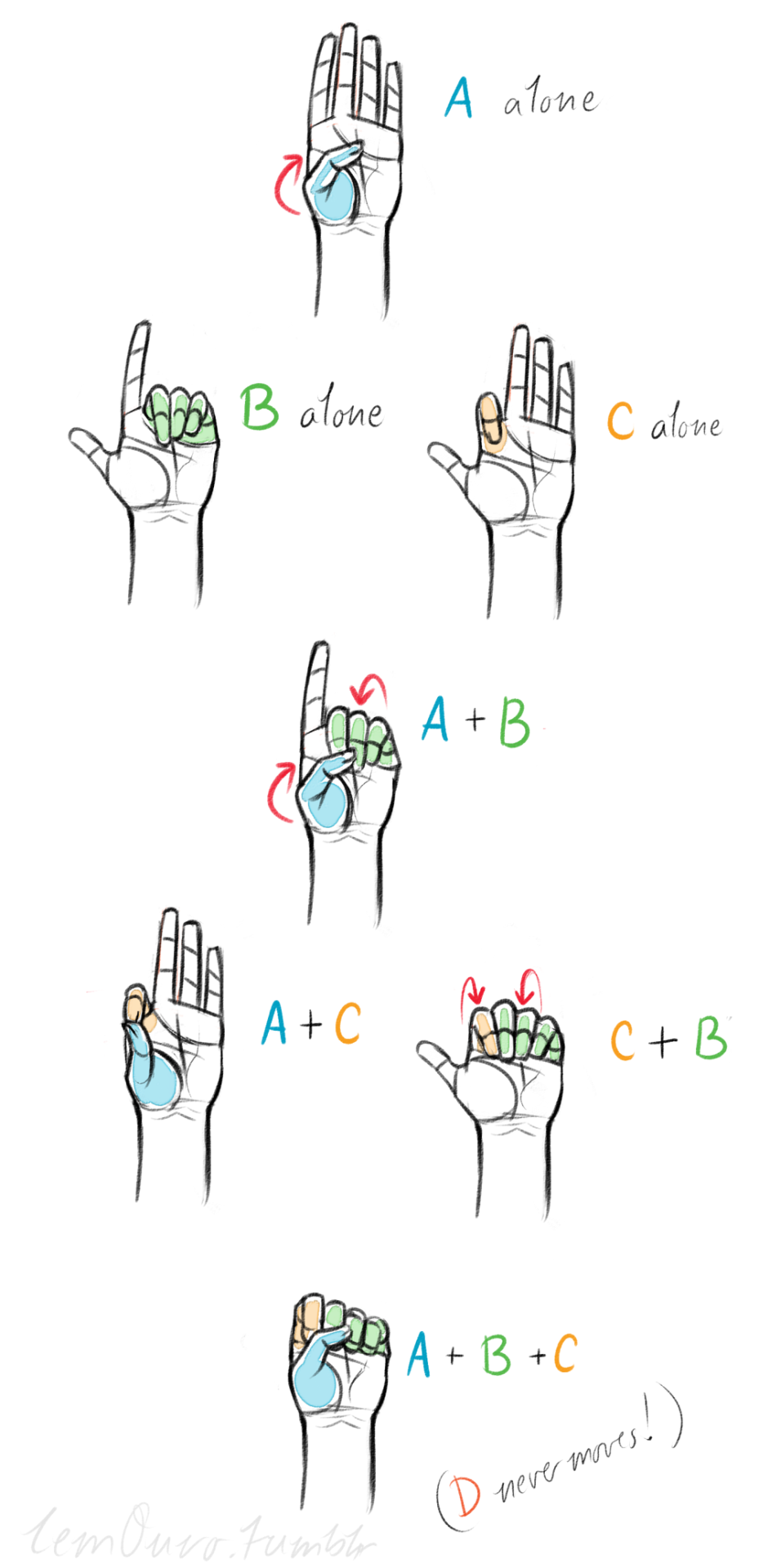
This is simply my method of drawing hands. God knows there are hundreds of tutorials out there by other artists, but personally, this way helps me the best (after learning the anatomy first).
This way I can divide the hand and combine the parts in any such way I need!
Hands take a lot of effort to grapple, and you need to practice them a lot, especially foreshortening of the hand; that’s really something you need to learn through your own studies. Look at your own hands, draw hands from life, from magazines, shows, comics; just draw hands! You’ll eventually figure out a method that works best for you. So to get better at drawing hands; draw hands!! And don’t stress over it, have fun with it!

-
 uselessyellow liked this · 1 year ago
uselessyellow liked this · 1 year ago -
 ryulatte liked this · 3 years ago
ryulatte liked this · 3 years ago -
 litchi-the-litch liked this · 4 years ago
litchi-the-litch liked this · 4 years ago -
 syllaw-16 liked this · 4 years ago
syllaw-16 liked this · 4 years ago -
 greatness-today-better-tommrow reblogged this · 4 years ago
greatness-today-better-tommrow reblogged this · 4 years ago -
 letal09 reblogged this · 4 years ago
letal09 reblogged this · 4 years ago -
 letal09 liked this · 4 years ago
letal09 liked this · 4 years ago -
 bradleyjeffreyjordan reblogged this · 4 years ago
bradleyjeffreyjordan reblogged this · 4 years ago -
 bradleyjeffreyjordan liked this · 4 years ago
bradleyjeffreyjordan liked this · 4 years ago -
 decadentkidstrawberry liked this · 4 years ago
decadentkidstrawberry liked this · 4 years ago -
 111ym reblogged this · 4 years ago
111ym reblogged this · 4 years ago -
 sugiwara liked this · 4 years ago
sugiwara liked this · 4 years ago -
 serenatsukinopizarro liked this · 4 years ago
serenatsukinopizarro liked this · 4 years ago -
 yanas108 liked this · 4 years ago
yanas108 liked this · 4 years ago -
 witcheart liked this · 4 years ago
witcheart liked this · 4 years ago -
 devastationz reblogged this · 4 years ago
devastationz reblogged this · 4 years ago -
 sushigrade reblogged this · 4 years ago
sushigrade reblogged this · 4 years ago -
 sushigrade liked this · 4 years ago
sushigrade liked this · 4 years ago -
 atsu-i reblogged this · 4 years ago
atsu-i reblogged this · 4 years ago -
 no-blanket reblogged this · 4 years ago
no-blanket reblogged this · 4 years ago -
 existentia1crisis reblogged this · 4 years ago
existentia1crisis reblogged this · 4 years ago -
 e1aena liked this · 4 years ago
e1aena liked this · 4 years ago -
 no-blanket liked this · 4 years ago
no-blanket liked this · 4 years ago -
 essence-of-nightshade liked this · 4 years ago
essence-of-nightshade liked this · 4 years ago -
 nayaxhq liked this · 4 years ago
nayaxhq liked this · 4 years ago -
 tuttifrui reblogged this · 4 years ago
tuttifrui reblogged this · 4 years ago -
 sugarshinebb liked this · 4 years ago
sugarshinebb liked this · 4 years ago -
 wisterieul reblogged this · 4 years ago
wisterieul reblogged this · 4 years ago -
 wisterieul liked this · 4 years ago
wisterieul liked this · 4 years ago -
 vodkasatan liked this · 4 years ago
vodkasatan liked this · 4 years ago -
 wotakuhime liked this · 4 years ago
wotakuhime liked this · 4 years ago -
 kida23 reblogged this · 4 years ago
kida23 reblogged this · 4 years ago -
 shigatsukanojo reblogged this · 4 years ago
shigatsukanojo reblogged this · 4 years ago -
 holyastra reblogged this · 4 years ago
holyastra reblogged this · 4 years ago -
 holyastra liked this · 4 years ago
holyastra liked this · 4 years ago -
 screw-yaa liked this · 4 years ago
screw-yaa liked this · 4 years ago -
 noisecannon liked this · 4 years ago
noisecannon liked this · 4 years ago -
 murilojr1106 liked this · 4 years ago
murilojr1106 liked this · 4 years ago -
 faceofoyku liked this · 4 years ago
faceofoyku liked this · 4 years ago -
 l0st-sovl reblogged this · 4 years ago
l0st-sovl reblogged this · 4 years ago -
 campstew liked this · 4 years ago
campstew liked this · 4 years ago

















